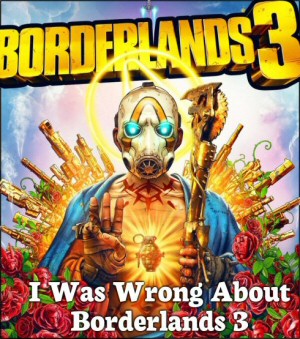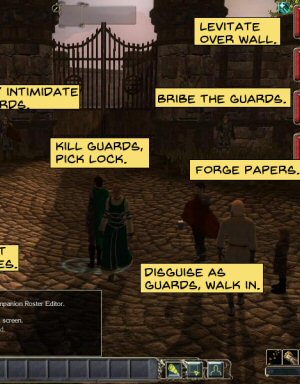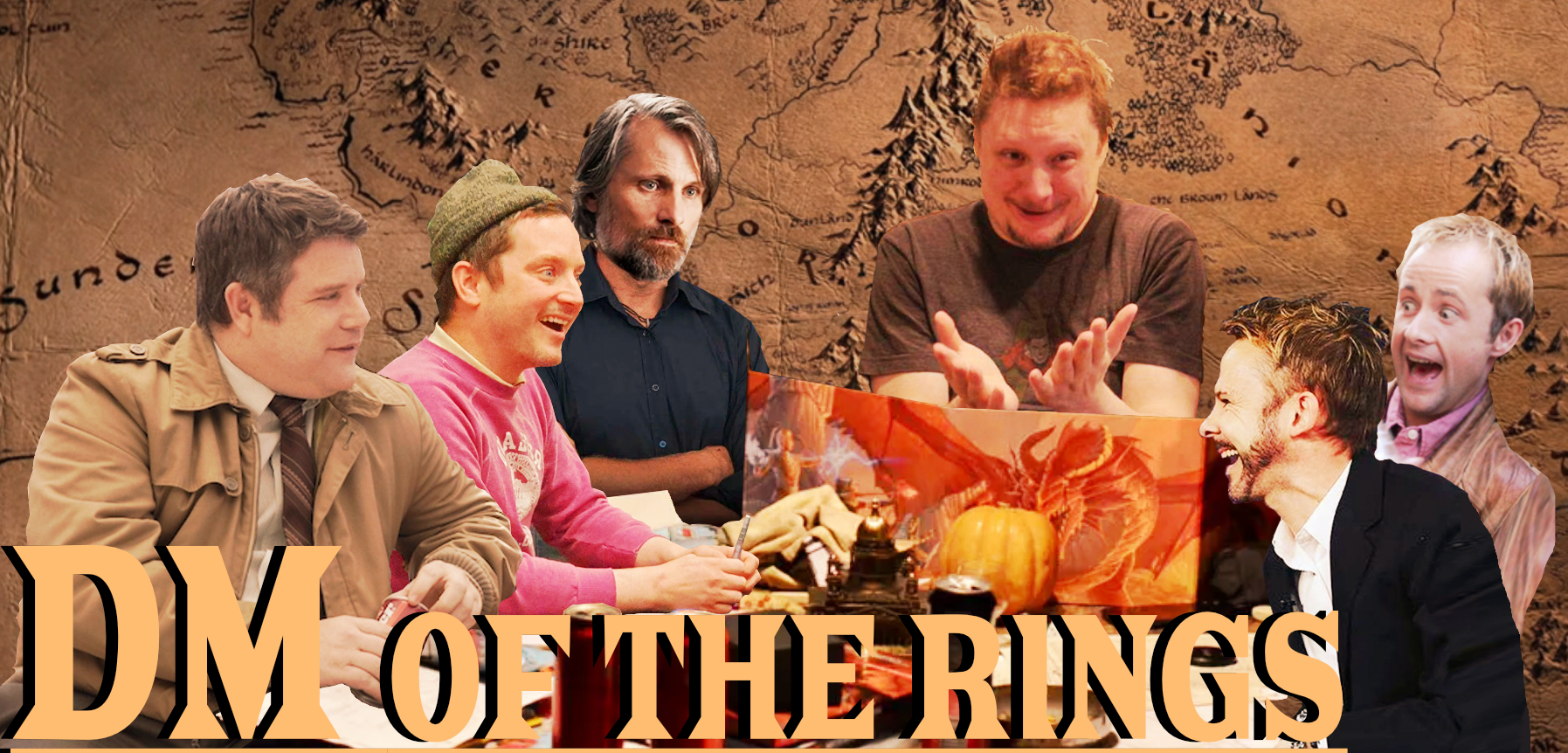
And here I finally deliver the joke / point I wanted to make way back in strip #16. The rules as presented in the rulebook seem sensible enough: If someone enters a square adjacent to an enemy, that enemy gets a free swing at them, right then and there, regardless of who’s turn it is. I’m sure proponents of the system can give you a nice list of reasons for this, why it makes combat more realistic, or what exploit it is supposed to counter.
– Shamus, Wednesday Dec 6, 2006
Civilization VI

I'm a very casual fan of the series, but I gave Civilization VI a look to see what was up with this nuclear war simulator.
I Was Wrong About Borderlands 3

I really thought one thing, but then something else. There's a bunch more to it, but you'll have to read the article.
The Plot-Driven Door

You know how videogames sometimes do that thing where it's preposterously hard to go through a simple door? This one is really bad.
Why The Christmas Shopping Season is Worse Every Year

Everyone hates Black Friday sales. Even retailers! So why does it exist?
Object-Oriented Debate

There are two major schools of thought about how you should write software. Here's what they are and why people argue about it.
 T w e n t y S i d e d
T w e n t y S i d e d

No comment from you, Bay Jubilee? Thanks for the HD remaster of DM of the rings by the way! It seems the same on the phone but each time that I got to see it on PC I am agreably surprised!
Not this week, I’ve got some real-life stuff going on, and the stressful launch of my book, and needed a break. Glad you’re enjoying it
No problem. Thanks again for your work and take care of yourself!
However we’ll intentioned, when you make a change to the rules to “fix” one thing that sometimes gives unintuitive results, you need to make a whole host of other things at the same “level” similarly realistic, or you’ve just introduced N new problems of the same form of the one you’re solving (“hey, the way the current rules work in this case doesn’t seem completely realistic!”)
I have a GM like that, Don’t get me wrong he’s a great GM overall and, to be fair, I’d say he’s been able to reign his oversimulationist instincts in recent years, plus he is willing to go the distance to houserule or tailor aspects of the mechanics to smooth things out.
But left completely to his own devices he is simulationist to the bone. Essentially “if it can be done by a character there should be a roll for it”. In one long running campaign we’ve reached a point where having sex required three separate rolls of relatively medium difficulty. It was like “Dude, you made sex literally harder than spellcasting. People have sex all the time! Amateurs have been pretty effective with it for thousands of years!”
(We’ll get to sex in tabletop later in the comics but this is the most prominent example I can think of)
Thankfully 5e seems to have simplified the opportunity attack rules and it only triggers now if something leaves a square adjacent to you without first using the disengage action. Enemies can run up to you all they like, they just can’t move away at will. The rules also specifically prohibit opportunity attacks on targets that have been pushed/shoved or otherwise moved in a way that doesn’t use movement points.
They can also run circles around you without provoking opportunity attacks, which in some ways is great because it allows some mobility, but it also trivializes movement in combat which can get awkward.
I’ve never played D&D (though I’ve played some video games that use part of the ruleset, like Neverwinter Nights 2 and Planescape: Torment), but that second point sounds like primo exploit material. Like, the party finds/crafts some magic sword that pushes the wielder back a tile w/o hurting them after every attack, hands it to the party fighter/barbarian/big tough hitting person, hilarity ensues.
This is how it worked in 3.5, too, although looking at the comments on the old post it seems like this wasn’t widely understood. I think the “you don’t provoke when you’re forced to move” bit might be new, though.
Oh 3.x attack of opportunity, such a complicated relationship I have with you. In premise it’s a great idea – why would somebody waste their time ineffectually slapping the guy in full plate and a shield instead of running back to stab that squishy, squishy mage throwing fireballs at all his friends? Well, let the guy in plate punish you for trying to run away of course!
And yet, in practice it falls apart to so many exceptions and caveats as Shamus says, that it turns into an absolute mess.
Though even with that, every other iteration of AOO irks me in some novel way that I keep going back to wanting that implementation.
Reading Shamus’s old comments, I’m imagining some kind of puzzly tactics game where you try to knock enemies between different character’s zones of control like ping-pong balls to trigger more attacks of opportunity.
Not something you’d want to do in pen and paper of course.
I recall seeing a build on the Character Optimization forums called “The Pinball Brothers.” One character had a bunch of attacks that inflicted knockback, and the other had a spiked chain (weapon of choice for AoO cheese), combat reflexes, and a bunch of feats that made AoOs better.
I’m glad I decided D&D’s rules were a garbage fire and had dumped running the game long before 3e showed. Don’t have these problems in GURPS…
I love GURPS, and also played it in preference to D&D starting long before the D&D 3E era, but I would not consider “simple, straightforward combat with no fiddly bits to stop and have to figure out” to be a particular strength of GURPS, a system that made a distinction between cover and concealment and expected you to keep track of whether or not a complex object had taken enough damage to no longer useful for its original purpose as well as whether it was destroyed. (Both of those are rules which definitely add to realism, but which are not the kind of thing you’d be tracking in a simple, straightforward combat system that prioritized speed of resolution over accurate simulation. Those are just the ones I remember offhand, without going to consult the Basic Set.)
My statement was with tongue firmly planted in check. GURPS can be simple, most of what you’re referring to are optional rules which your GM turned on. But yeah, it’s loved by it’s devout fanatics because there are so many optional fiddly bits they can turn to better “replicate” reality that it’s just as bad as the worst of D&D.
It’s real biggest drawback is front-loading the complications to character generation, instead of back-loading it in “build” like modern D&D does (and while there are ways around that, it removes the other big draw: being able to make a completely customized character)..
Yeah the immediate exploit I thought of was three party members in a line but they can’t quite reach the walls. So half the orcs run around them, allowing for sneak attack from the others.
On second thought, it’s more likely the party rogue who does an end run – but it’s the same tactic.
Fixing it does make combat a lot more complicated. And a lot more static – 3rd edition combats tended to end up in two lines.
“Closing provokes” was never a thing in 3rd though. It only provoked if you had more than 5 foot reach, so closing meant you were leaving the square 10 feet away that was threatened.
I don’t remember if push/pull provoked – those things were introduced in splatbooks, so I doubt they were playtested all that well. Integrating all the maneuvers in 5th was a good move (as it were).
This was my reaction to entering D&D – “why is this more complex than most people’s jobs, scratch that, careers? You know there are computers and game engines to deal with all this?” Getting people to play D&D isn’t like asking someone to play tennis. It’s like asking someone to learn a new language and history to become the manager of a small business in a foreign country – “it’s fun once you know what you’re doing!” :P
Saying that, I love working it all out – coming up with ways to maximise damage or optimise situations. I think it sometimes comes across as trying to “get away with stuff” and the DM says things like “fine but if you’re going to claim these hokey things then the enemies can do BS things to you too”. But I’m not, I just want to make the best of what we have within the rules – not bend the rules.
Pretty much all of my (few) D&D friends did arty subjects at university. Creative writing, English literature, sociology, floristry. Makes me wonder what potential they had in science and engineering. But science and engineering is so boring in practice. But most of them have ended up working in shops or admin, and one English teacher. But maybe then having more analytical complexity at work would mean less brain availability for complexity in hobbies! It’s the creative bits of D&D that really stymie me, when I actually have to roleplay instead of just making decisions and problem solving.
Yeah, we just skipped those kind of rules in favour of letting the DM decide what seems realistic enough, and then arguing for ages about why their decisions made no sense, and finding that we should have been more clear about who was doing what and where because I thought I was gonna be able to jump on the table this turn but the DM says I’ll need one turn move away from the table and another for a running leap, during which I’ll be defenseless, and then I realize if that was so I would not have positioned myself right next to that stupid table but now it’s too late and I’m getting swarmed here.
It’s kind of a minefield. I sometimes tried to navigate that by telling the DM beforehand what my plan was, but at least one of the DMs I played with loved to use that knowledge to foil my plans and make me look like an idiot.